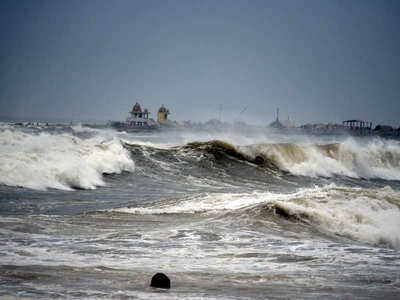- News
- India News
- States in east India highly vulnerable to climate change, says first such assessment report
Trending
This story is from April 17, 2021
States in east India highly vulnerable to climate change, says first such assessment report

NEW DELHI: Jharkhand, Mizoram, Orissa, Chhattisgarh, Assam, Bihar, Arunachal Pradesh and West Bengal, mostly eastern part of India, are ‘highly vulnerable’ to climate change, said the first of its kind national level state and district-wise climate vulnerability assessment report, released by the science & technology ministry on Saturday. It showed Maharashtra as the least vulnerable state in the country. 
It noted that Assam, Bihar, and Jharkhand have, in fact, over 60% districts in the category of 'highly vulnerable' districts with Karimganj in Assam being the most vulnerable.
The report – titled Climate Vulnerability Assessment for Adaptation Planning in India Using a Common Framework – noted that all districts or states are vulnerable, but some are relatively more vulnerable than others, requiring prioritised adaptation interventions to face the impact of climate change such as extreme weather events, stress on water resources, soil degradation and desertification.

Besides Maharashtra, the states which figured in the ‘low vulnerability’ category include Goa, Nagaland, Kerala, Tamil Nadu, Haryana, Uttarakhand, Punjab Sikkim, Telangana and Himachal Pradesh. On the other hand, erstwhile state of Jammu & Kashmir is figured in the ‘moderate vulnerability’ list along with Uttar Pradesh, Tripura, Gujarat, Meghalaya, Rajasthan, Madhya Pradesh, Manipur, Andhra Pradesh and Karnataka.

A total of 94 representatives from 24 states and 2 Union Territories (UTs) participated in the nation-wide exercise to come up with the assessment report, jointly supported by the DST and the Swiss Agency for Development & Cooperation (SDC). The state-level analysis had been carried out by the research team of IIT Mandi, IIT Guwahati and IISc Bengaluru.
State and district-level vulnerability indices are prepared, factoring in socio-economic features and livelihood; biophysical aspects (yield variability of food-grains, area under rainfed agriculture, forest area per 1000 rural population and incidences of vector-borne and water-borne diseases); and institution and infrastructure such as area covered under centrally funded crop insurance schemes, implementation of Mahatma Gandhi National Rural Employment Guarantee Act (MGNREGA), road and rail-network and density of healthcare workers.
The Socio-economic features and livelihood status looked at percentage of population living below the poverty line (BPL), income share from natural resources, share of horticulture in agriculture, proportion of marginal and small landholdings, and women’s participation in the workforce as factors to prepare the vulnerability indices and a common framework.
Such assessment reports are critical for developing adaptation projects for the Green Climate Fund, Adaptation Fund, and funds from multilateral and bilateral agencies. It may also aid to plan disaster management.
“The assessments can further be used for India’s reporting on the Nationally Determined Contributions (NDCs) under the Paris Agreement. And finally, these assessments will support India’s national action plan on climate change,” said Corinne Demenge, head, Swiss Cooperation Office, Embassy of Switzerland in India.

It noted that Assam, Bihar, and Jharkhand have, in fact, over 60% districts in the category of 'highly vulnerable' districts with Karimganj in Assam being the most vulnerable.
The report – titled Climate Vulnerability Assessment for Adaptation Planning in India Using a Common Framework – noted that all districts or states are vulnerable, but some are relatively more vulnerable than others, requiring prioritised adaptation interventions to face the impact of climate change such as extreme weather events, stress on water resources, soil degradation and desertification.

“We have seen how extreme events are on the rise both in terms of their number and severity. Mapping the parts of India that are vulnerable to such changes will help initiate climate actions at the ground level,” said Ashutosh Sharma, secretary, department of science and technology (DST).
Besides Maharashtra, the states which figured in the ‘low vulnerability’ category include Goa, Nagaland, Kerala, Tamil Nadu, Haryana, Uttarakhand, Punjab Sikkim, Telangana and Himachal Pradesh. On the other hand, erstwhile state of Jammu & Kashmir is figured in the ‘moderate vulnerability’ list along with Uttar Pradesh, Tripura, Gujarat, Meghalaya, Rajasthan, Madhya Pradesh, Manipur, Andhra Pradesh and Karnataka.

A total of 94 representatives from 24 states and 2 Union Territories (UTs) participated in the nation-wide exercise to come up with the assessment report, jointly supported by the DST and the Swiss Agency for Development & Cooperation (SDC). The state-level analysis had been carried out by the research team of IIT Mandi, IIT Guwahati and IISc Bengaluru.
State and district-level vulnerability indices are prepared, factoring in socio-economic features and livelihood; biophysical aspects (yield variability of food-grains, area under rainfed agriculture, forest area per 1000 rural population and incidences of vector-borne and water-borne diseases); and institution and infrastructure such as area covered under centrally funded crop insurance schemes, implementation of Mahatma Gandhi National Rural Employment Guarantee Act (MGNREGA), road and rail-network and density of healthcare workers.
The Socio-economic features and livelihood status looked at percentage of population living below the poverty line (BPL), income share from natural resources, share of horticulture in agriculture, proportion of marginal and small landholdings, and women’s participation in the workforce as factors to prepare the vulnerability indices and a common framework.
Such assessment reports are critical for developing adaptation projects for the Green Climate Fund, Adaptation Fund, and funds from multilateral and bilateral agencies. It may also aid to plan disaster management.
“The assessments can further be used for India’s reporting on the Nationally Determined Contributions (NDCs) under the Paris Agreement. And finally, these assessments will support India’s national action plan on climate change,” said Corinne Demenge, head, Swiss Cooperation Office, Embassy of Switzerland in India.
End of Article
FOLLOW US ON SOCIAL MEDIA










